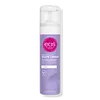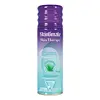EOS Shea Better 24H Moisture Shave Cream Versus Skintimate Skin Therapy Sensitive Skin Women's Shave Gel
What's inside
What's inside
 Key Ingredients
Key Ingredients

 Benefits
Benefits

 Concerns
Concerns

 Ingredients Side-by-side
Ingredients Side-by-side

Water
Skin ConditioningCetyl Alcohol
EmollientPropylene Glycol
HumectantGlycerin
HumectantCocoglycerides
EmollientStearyl Alcohol
EmollientLaureth-23
CleansingCI 77891
Cosmetic ColorantColloidal Oatmeal
AbsorbentPetrolatum
EmollientGlyceryl Stearate Se
EmulsifyingButyrospermum Parkii Oil
EmollientButyrospermum Parkii Butter
Skin ConditioningAloe Barbadensis Leaf Juice
Skin ConditioningLavandula Angustifolia Flower Extract
CleansingDimethicone
EmollientCaprylyl Glycol
EmollientParfum
MaskingPhenoxyethanol
PreservativeMagnesium Aluminum Silicate
AbsorbentPotassium Sorbate
PreservativeCarbomer
Emulsion StabilisingHexylene Glycol
EmulsifyingDisodium EDTA
Tocopheryl Acetate
AntioxidantAscorbyl Palmitate
AntioxidantSodium Hydroxide
BufferingCitric Acid
BufferingSodium Benzoate
MaskingCitronellol
PerfumingCoumarin
PerfumingGeraniol
PerfumingLimonene
PerfumingLinalool
PerfumingWater, Cetyl Alcohol, Propylene Glycol, Glycerin, Cocoglycerides, Stearyl Alcohol, Laureth-23, CI 77891, Colloidal Oatmeal, Petrolatum, Glyceryl Stearate Se, Butyrospermum Parkii Oil, Butyrospermum Parkii Butter, Aloe Barbadensis Leaf Juice, Lavandula Angustifolia Flower Extract, Dimethicone, Caprylyl Glycol, Parfum, Phenoxyethanol, Magnesium Aluminum Silicate, Potassium Sorbate, Carbomer, Hexylene Glycol, Disodium EDTA, Tocopheryl Acetate, Ascorbyl Palmitate, Sodium Hydroxide, Citric Acid, Sodium Benzoate, Citronellol, Coumarin, Geraniol, Limonene, Linalool
Water
Skin ConditioningPalmitic Acid
EmollientTriethanolamine
BufferingSunflower Seed Oil Glyceride
EmollientIsopentane
SolventSorbitol
HumectantStearic Acid
CleansingIsobutane
Pvp
Emulsion StabilisingTocopheryl Acetate
AntioxidantPEG-90m
Emulsion StabilisingHydrogenated Vegetable Oil
EmollientOlea Europaea Fruit Oil
MaskingAloe Barbadensis Leaf Juice
Skin ConditioningParfum
MaskingTitanium Dioxide
Cosmetic ColorantCI 16035
Cosmetic Colorant
 Reviews
Reviews

Ingredients Explained
These ingredients are found in both products.
Ingredients higher up in an ingredient list are typically present in a larger amount.
Aloe Barbadensis Leaf Juice comes from leaves of the aloe plant. Aloe Barbadensis Leaf Juice is best known for helping to soothe sunburns. It is also anti-inflammatory, moisturizing, antiseptic, and can help heal wounds.
Aloe is packed with good stuff including Vitamins A, C, and E. These vitamins are antioxidants, which help fight free-radicals and the damage they may cause. Free-radicals are molecules that may damage your skin cells, such as pollution.
Aloe Barbadensis Leaf Juice also contains sugars. These sugars come in the form of monosaccharides and polysaccharides, folic acid, and choline. These sugars are able to help bind moisture to skin.
It also contains minerals such as calcium, 12 anthraquinones, fatty acids, amino acids, and Vitamin B12.
Learn more about Aloe Barbadensis Leaf JuiceParfum is a catch-all term for an ingredient or more that is used to give a scent to products.
Also called "fragrance", this ingredient can be a blend of hundreds of chemicals or plant oils. This means every product with "fragrance" or "parfum" in the ingredients list is a different mixture.
For instance, Habanolide is a proprietary trade name for a specific aroma chemical. When used as a fragrance ingredient in cosmetics, most aroma chemicals fall under the broad labeling category of “FRAGRANCE” or “PARFUM” according to EU and US regulations.
The term 'parfum' or 'fragrance' is not regulated in many countries. In many cases, it is up to the brand to define this term.
For instance, many brands choose to label themselves as "fragrance-free" because they are not using synthetic fragrances. However, their products may still contain ingredients such as essential oils that are considered a fragrance by INCI standards.
One example is Calendula flower extract. Calendula is an essential oil that still imparts a scent or 'fragrance'.
Depending on the blend, the ingredients in the mixture can cause allergies and sensitivities on the skin. Some ingredients that are known EU allergens include linalool and citronellol.
Parfum can also be used to mask or cover an unpleasant scent.
The bottom line is: not all fragrances/parfum/ingredients are created equally. If you are worried about fragrances, we recommend taking a closer look at an ingredient. And of course, we always recommend speaking with a professional.
Learn more about ParfumTocopheryl Acetate is AKA Vitamin E. It is an antioxidant and protects your skin from free radicals. Free radicals damage the skin by breaking down collagen.
One study found using Tocopheryl Acetate with Vitamin C decreased the number of sunburned cells.
Tocopheryl Acetate is commonly found in both skincare and dietary supplements.
Learn more about Tocopheryl AcetateWater. It's the most common cosmetic ingredient of all. You'll usually see it at the top of ingredient lists, meaning that it makes up the largest part of the product.
So why is it so popular? Water most often acts as a solvent - this means that it helps dissolve other ingredients into the formulation.
You'll also recognize water as that liquid we all need to stay alive. If you see this, drink a glass of water. Stay hydrated!
Learn more about Water